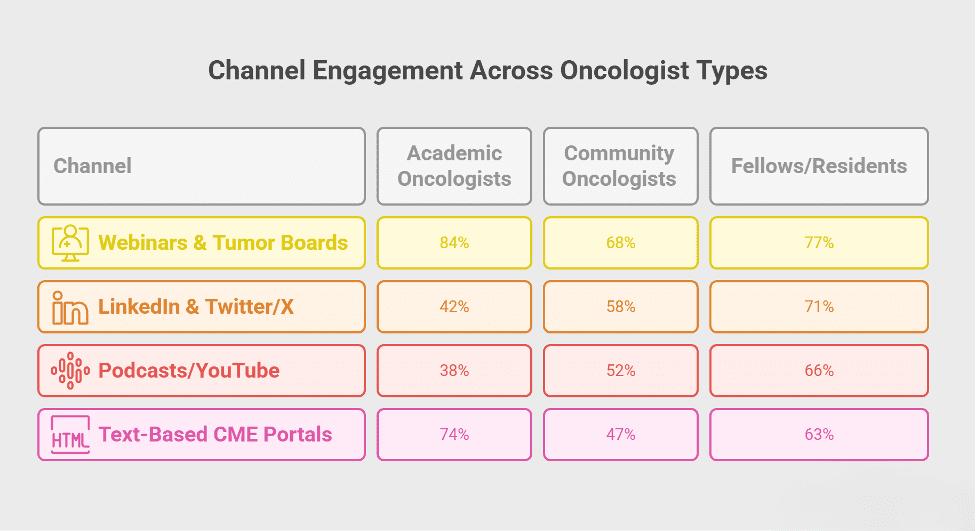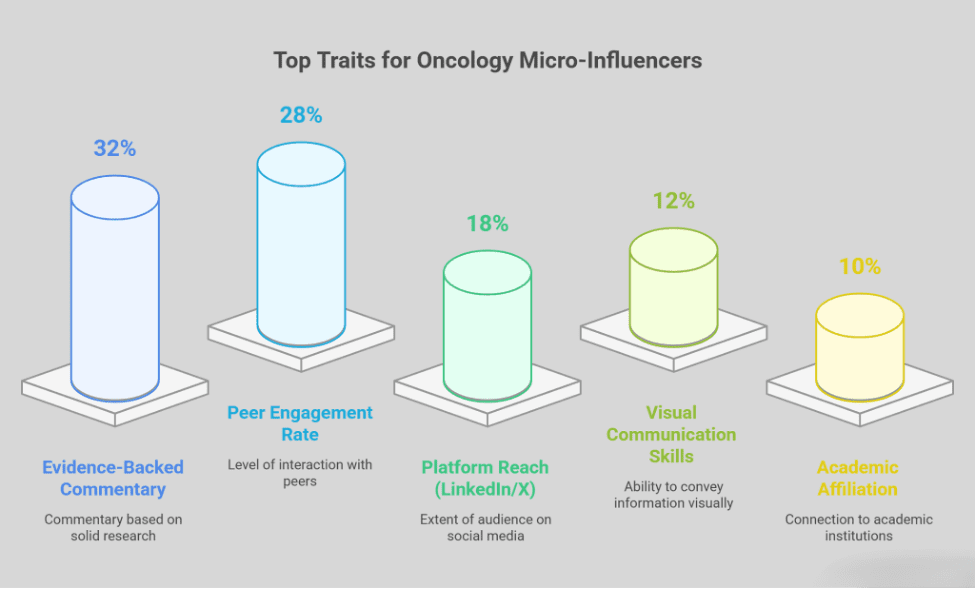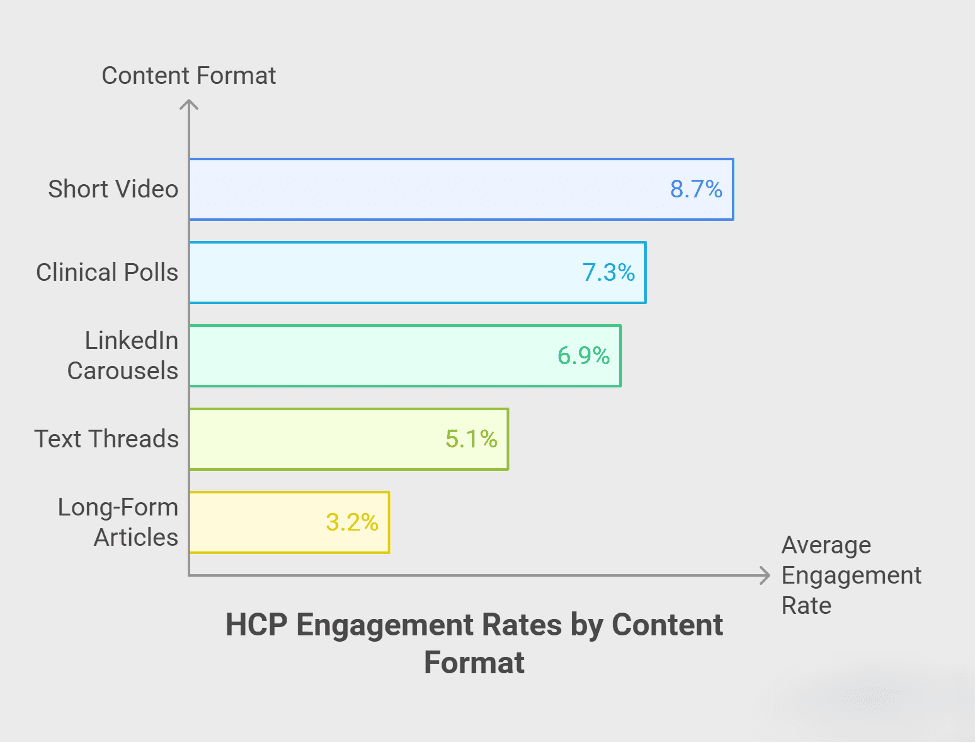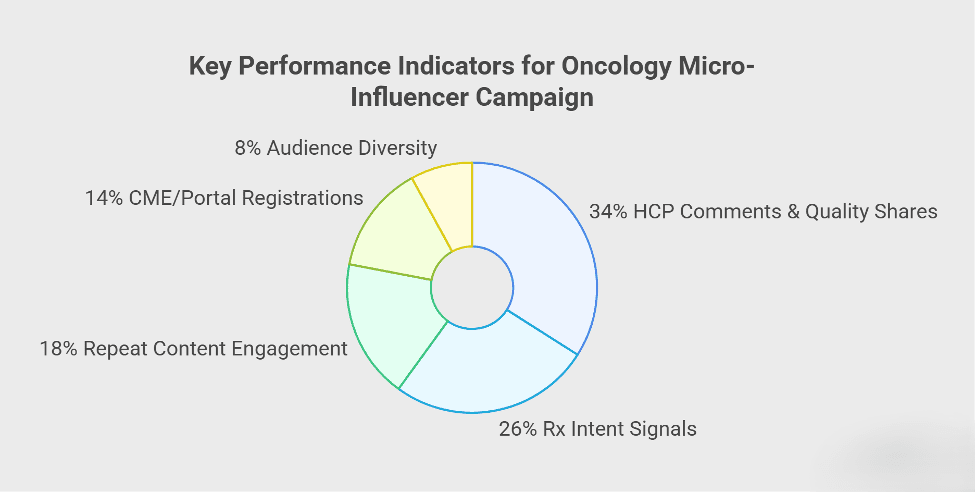Introduction: Transforming Influence Amid Precision Medicine Paradigms
The discipline of oncology is undergoing an epistemic and operational evolution, not only through molecular advances and therapeutic innovation but also in the mechanisms by which information dissemination and clinical consensus are achieved among healthcare professionals (HCPs). While key opinion leaders (KOLs) maintain relevance in shaping macro-level clinical discourse, a decentralized cohort of digitally active oncologists is emerging as a formidable conduit for micro-level peer influence via digital platforms, interactive content ecosystems, and virtual continuing medical education (CME) infrastructures.
To meet this shift, pharmaceutical marketing strategies must pivot from transactional messaging toward a model of precision engagement anchored in trust, data-driven insights, and contextual relevance. This article examines the reconfiguration of digital influence within oncology and articulates how next-generation micro-networks-leveraging artificial intelligence (AI), modular content systems, and ethically aligned digital channels-are reshaping HCP engagement with measurable clinical and educational outcomes.
1. From KOLs to Knowledge Nodes: Rethinking Influence Mapping
The binary view of KOL vs. non-KOL is outdated. Influence now exists on a continuum. Many early-career oncologists are active on platforms like LinkedIn, YouTube, and Substack, becoming “knowledge nodes,” intermediaries who synthesize new research, contextualize trials, and guide their micro-communities.
Types of Modern Oncology Influencers:
- Peer Interpreters: Community oncologists breaking down new guidelines
- Content Curators: Mid-career HCPs sharing summarized literature via social posts
- Digital CME Hosts: Experts facilitating webinars, tumor boards, or panel Q&As

2. Micro-Influencers: Building Trust Through Peer-Level Dialogue
Unlike high-profile KOLs, micro-influencers operate within tight digital communities, often built around specific tumor types or practice settings. Their value lies in relatability, frequency of engagement, and low promotional fatigue.
Key Attributes of Effective Oncology Micro-Influencers:
- Publish 3–5 posts per week across platforms
- Prefer evidence-based but conversational tone
- Provoke comments and real peer debate
- Represent diverse geographies and patient populations

3. AI-Enabled Mapping: Identifying Digital Influence Beyond Follower Count
Traditional influencer selection relied on basic metrics like follower volume. Today, AI-enabled tools such as Symplur, HCP Universe, and IQVIA’s social signal engines allow nuanced tracking of:
- Topic expertise over time (e.g., lung cancer, biomarker testing)
- Audience type (HCP, academic, policy)
- Cross-platform influence
Example: An AI-based analysis of X (Twitter) showed that a lesser-known GI oncologist in Hyderabad consistently triggered post-conference engagement spikes during ASCO GI, despite only having ~800 followers.
4. Content That Converts: Shifting from Awareness to Activation
Content shared by micro-influencers must deliver educational utility-not brand slogans. Leading strategies include
- Short-form explainer videos on trial readouts
- Visual carousels comparing treatment regimens
- Polls and quizzes on diagnostic dilemmas
Modular content platforms (e.g., Viseven, IQVIA Orchestrated Content) allow pharma teams to:
- Pre-tag assets by tumor type, format, and audience
- Enable influencer personalization within MLR-approved boundaries
- Track reuse, engagement, and content lineage

5. Compliance 2.0: Guardrails for the Digital Era
While creativity and authenticity are key, they must operate within ethical and regulatory frameworks:
- Transparency: Clear labelling of sponsored posts and partnerships
- Content Validation: All shared materials should pass MLR or medical review
- Consent for Metrics: Influencer campaign data must comply with GDPR/India DPDPA
- No Off-Label Implications: Content should avoid inferring unapproved uses
Best Practice: Co-develop an “influencer starter kit” that includes disclaimer templates, brand safety principles, and platform-specific dos and don’ts.
6. Measuring What Matters: Engagement, Impact, and ROI
Avoid vanity metrics like total impressions. Instead, use:
- Quality of Engagement: Comments from verified HCPs, shares with added insights
- Conversion Rate: Webinar sign-ups, portal visits, eDetail requests
Time-on-Content: Especially on video explainers and interactive assets

7. Future Forward: Evolving the Influence Model in Oncology
Looking ahead, pharma marketers should prepare for:
- Decentralized Influencer Panels: Slack/WhatsApp-based peer circles co-creating content
- Virtual Tumor Boards on Demand: Hosted by micro-influencers for post-trial debate
- Real-World Data Collaborations: DOLs commenting on patient-level outcome patterns
- AR/VR Formats: Immersive explainers with HCP avatars
8. Integrating Influence Strategies with Multichannel Engagement Ecosystems
To fully actualize the potential of oncology micro-influencers, pharmaceutical organizations must embed influencer-led strategies into a broader omnichannel engagement framework. Doing so facilitates consistent messaging, optimizes content sequencing, and creates seamless educational experiences for HCPs.
Key Components of Integration:
- Dynamic CRM Segmentation: Micro-influencer interactions can be layered into CRM databases to refine behavioral segments and customize follow-up communication. For instance, if an HCP interacts with a DOL’s LinkedIn post on molecular diagnostics, they may receive a personalized eDetailing invitation centered on the same theme.
- Triggered Content Ecosystems: Engagement with influencer-led content should dynamically activate supplementary educational assets. A viewed Instagram Reels video may prompt a follow-up email with a visual explainer on biomarker pathways.
- Cross-Platform Synchronization: Ensure consistency of tone and data across webinars, social posts, interactive dashboards, and CME portals. Micro-influencers become the unifying thread across these nodes, creating coherence in the HCP experience.
Moreover, micro-influencer content can serve as a high-performing entry point into deeper engagement journeys. Analytics reveal that posts led by peer voices often have higher “scroll depth” and “click-through-to-portal” rates than equivalent branded posts.
9. Case Study Expansion: Regional Strategy in Emerging Markets
Global pharmaceutical organizations increasingly seek to localize digital engagement by activating micro-influencers in regional or underrepresented markets. This is especially important in oncology, where disease burden and treatment patterns can vary dramatically across geographies.
Case Snapshot: Latin America Oncology DOL Activation
- Objective: Promote education on PD-1 inhibitors in NSCLC across Argentina, Brazil, and Colombia
- Approach: Identify six regionally respected thoracic oncologists active on X (Twitter) and WhatsApp groups; provide modular Spanish/Portuguese educational content co-developed by MSLs
- Execution: A campaign comprising 12 bilingual threads, 3 WhatsApp peer circles, and 2 virtual CME tumor boards
- Outcome:
- 2.8x increase in branded microsite traffic
- 39% of webinar registrants reported learning about the CME via peer DOL content
- Marked increase in prescription intent scores post-campaign (via longitudinal survey)
This case underscores the importance of culturally and linguistically contextualized DOL activation, with localization integrated into influencer and content strategy.
10. Behavioral Science and Influence Nudging in Oncology Education
Advanced behavioral design principles are increasingly being used to enhance the impact of influencer content. By applying nudging theory and decision psychology, marketers can guide HCP behavior in ethically sound, clinically constructive ways.
Key Applications:
- Choice Architecture: Presenting diagnostic pathways or treatment algorithms through comparative visuals that clarify options without promoting specific products.
- Anchoring & Priming: Using DOL posts to pre-frame discussions around clinical challenges (e.g., treatment sequencing in HER2-low BC) before branded engagements occur.
- Social Norm Cues: Including implicit signals of peer consensus (e.g., poll results, expert quotes) to normalize behavior change (such as earlier genomic testing).
Behavioral nudges delivered through micro-influencer content yield superior retention and decision-making outcomes compared to neutral, fact-only formats. This approach is particularly effective for behaviorally entrenched patterns, such as adherence to outdated protocols or underutilization of companion diagnostics.
11. Influence in the Era of Tumor-Agnostic Approvals
With the rise of biomarker- and tissue-agnostic oncology treatments (e.g., NTRK, MSI-H/dMMR approvals), the influencer model must adapt to cross-disciplinary education needs. A gastrointestinal oncologist, for example, may require updates on rare biomarkers more traditionally seen in pediatric or sarcoma domains.
Influencer Strategy Evolution:
- Develop cross-specialty DOL panels that collaborate on integrated educational pieces
- Build explainer series that contextualize tumor-agnostic indications in organ-specific practice
- Empower influencers to host journal clubs or tumor board simulations addressing molecular eligibility regardless of tumor origin
Such integration reflects the complexity of modern oncology, where influence transcends departmental boundaries and requires a molecularly literate digital network.
12. Ethical Stewardship in the AI-Influence Interface
As AI tools increasingly determine influencer selection, content performance, and predictive campaign strategy, pharmaceutical organizations must evolve their ethical oversight mechanisms.
Emerging Ethical Concerns:
- Bias in AI Models: Algorithms trained on unbalanced datasets may overlook influencers from underrepresented institutions or regions
- Opaque Personalization Engines: Unclear rationale behind content sequencing can erode trust among HCPs
- Feedback Loop Amplification: Algorithms may prioritize influencers with polarizing views due to engagement spikes, creating skewed scientific discourse
Mitigation Framework:
- Periodic bias audits of AI influencer identification systems
- Transparency protocols that allow HCPs to understand why certain content is shown
- Governance boards inclusive of medical, compliance, and data science personnel
Building trust in AI-enhanced influencer ecosystems will be crucial to sustaining long-term credibility and avoiding reputational risk.
Conclusion: Strategic Influence in the Precision Oncology Era
The evolving oncology influence economy is characterized not by message saturation but by content credibility, contextual fluency, and peer resonance. Micro-influencers function as epistemic gatekeepers and facilitators of real-world knowledge translation. When empowered by AI mapping tools, modular content infrastructures, and ethical collaboration protocols-Long-Formthese professionals can substantively enhance the quality and impact of pharma-HCP engagement.
Pharmaceutical enterprises that invest in data-intelligent influencer ecosystems grounded in clinical utility and compliance will be optimally positioned to navigate and shape the future of digitally mediated oncology education.
Strategic Imperatives
- Reframe influencer classification to reflect network-based knowledge dynamics
- Deploy AI to identify high-fidelity, clinically active digital influencers
- Use modular content to support scalable, compliant personalization
- Prioritize KPIs linked to clinical action and knowledge dissemination
- Institutionalize ethical frameworks to guide influencer engagement practices
- Integrate behavioral nudging and regional content localization
- Audit AI and algorithmic bias in influencer selection frameworks
The Oncodoc team is a group of passionate healthcare and marketing professionals dedicated to delivering accurate, engaging, and impactful content. With expertise across medical research, digital strategy, and clinical communication, the team focuses on empowering healthcare professionals and patients alike. Through evidence-based insights and innovative storytelling, Hidoc aims to bridge the gap between medicine and digital engagement, promoting wellness and informed decision-making.



